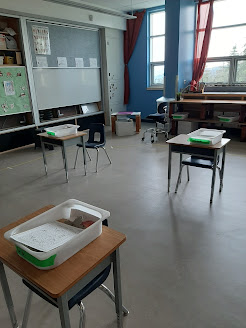1. I wanted to document my journey and my thinking.
2. Writing is a creative outlet for me, but it is also a way for me to process and reflect.
3. I wanted to share and reach out to anyone else who was thinking about Classroom Design for feedback, support, and for more ideas.
At the time, not a lot of people were thinking about how the way classrooms are set up affects learning. I remember working on this blog at the beginning, and my father in-law asked me, "Is Classroom Design a thing?" It was a foreign idea for him, thinking back to the classrooms he was in as a boy.
I haven't blogged much lately, other things taking up my time, but I have been thinking a lot about classroom design lately, and not by choice. In case you are from another planet or you are reading this many years in the future, due to the COVID 19 pandemic, schools were closed in the spring. In my jurisdiction (Vancouver-area, British Columbia, Canada), we shut down in March and returned to school with limited amounts of students in class in June. We were one of the few provinces to return in June.
What did June look like in my classroom?
- On Monday and Tuesday, I had 7 students in class. On Thursday and Friday, I had 4 students. (The rest of my 12 students I taught through home-based assignments and video conferences on Wednesdays).
- For the in-class students, every morning, I met them outside (I wore gloves and a face shield) and took them back to the classroom to wash their hands. They waited in line around the perimeter of my classroom which was marked with a vinyl tape line.
- Every day, we reviewed the safety and hygiene procedures.
- I rolled up the carpet, pushed the risers to the back, and brought in some desks. Each student was able to have their own desk and chair. It was their spot and they were 2 m away from each other.
- Each student had their own bin of materials, and their own individual work.
 |
| 2 m spaced desks |
1. At home learning and Classroom Design2. Return to class in June and Classroom Design3. Starting new in September and Classroom Design
- Seating and desks
- I have 10 desks left from June and 9 student chairs.
- I re-assembled 3 tables, but they might only allow for 6 students with minimal spacing.
- I will probably dismantle the risers because they are great for community, but not so good for avoiding contact and shared spaces.
- Access to the sink
- In June, we washed our hands about 10 times a day. We had a clear line while we were waiting in line that allowed safe spacing. In September, we will probably have to go in groups to line up for hand washing.
- Again, safety will be important, but in this case equally important will be the affective domain.
- Last time, one of the biggest "benefits" to going to home learning in partway through the year was we already had a pre-established community and some norms and routines in place. In September, I will probably have a new batch of students so I will have to find ways of bringing everyone together as a community.
- Beyond this, I want to focus on the emotional well-being of the students, and to decrease the fear and anxiety of coming to school in these unusual conditions, so I will work on using the classroom environment to create a sense of calm and comfort while still maintaining safety. I'll try things such as:
- warm, medium intensity lighting, not too bright, not too dull.
- a neutral, natural colour palette as much as possible in the students' main frame of sight.
- reducing the reverberation from the floor as much as possible. Taking the carpet out in June was okay with 7 students, chairs, and desks, but multiplying that number by 3 is going to create a lot more noise and amplified echo from the hard slick floor. I will continue to use my cobbled together mini-PA so every student can hear me without me having to shout.
- having lots of fresh air circulating through the classroom and including live plants.
I went into school today (since I began writing this). Here is what my classroom looks like so far:
 |
| 10 desks at the front, spaced about 1.5 m. |
 |
| 3 tables in the back. |
 |
| I made a prototype transparent vinyl barrier between students at the tables. |
 |
| For 4 students. |






No comments:
Post a Comment